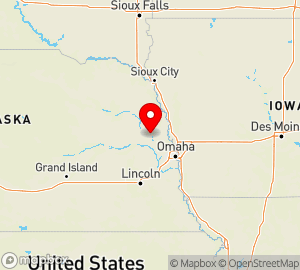Nebraska
Nebraska State Information

www.nebraska.gov
Area (sq mi):: 77353.73 (land 76872.41; water 481.31) Population per square mile: 22.90
Population 2005: 1,758,787 State rank: 0 Population change: 2000-20005 2.80%; 1990-2000 8.40% Population 2000: 1,711,263 (White 87.30%; Black or African American 4.00%; Hispanic or Latino 5.50%; Asian 1.30%; Other 5.10%). Foreign born: 4.40%. Median age: 35.30
Income 2000: per capita $19,613; median household $39,250; Population below poverty level: 9.70% Personal per capita income (2000-2003): $27,625-$30,179
Unemployment (2004): 3.90% Unemployment change (from 2000): 1.10% Median travel time to work: 18.00 minutes Working outside county of residence: 19.40%
List of Nebraska counties:
Nebraska Parks
- US National Parks
- Urban Parks
- State Parks
- Parks and Conservation-Related Organizations - US
- National Wildlife Refuges
- National Trails
- National Grasslands
- National Forests
Nebraska
Thirty-seventh state; admitted on March 1, 1867
Nebraska’s admission day anniversary is marked as State Day. On March 1 every year, state law requires the governor to issue a proclamation about the anniversary and call on citizens to celebrate. Schools may mark the occasion with programs about the state’s history. The centennial celebration was held during much of 1967 with festivals, rodeos, pageants, and exhibits.
State capital: Lincoln Nicknames: Cornhusker State; Tree Planters’ State State motto: Equality Before the Law State ballad: “A Place Like Nebraska” State baseball capital: Wakefield State beverage: milk State bird: Western meadowlark (Sturnella neglecta) State Christmas tree: Colorado blue spruce (planted near
the capital in 1876) State fish: Channel cutfish (Ictalurus punctatus) State flower: Goldenrod (Solidago serotina) State folk dance: Square dance State fossil: Mammoth State gem: Blue agate (blue chalcedony) State grass: Little bluestem (Schizachyrium scoparium),
also called “bunch grass” or “beard grass” State historic baseball capital: St. Paul State insect: Honeybee (Apis mellifera) State mammal: Whitetail deer (Odocoileus virginianus) State poet laureate: John G. Neihardt State river: Platte River State rock: Prairie agate State slogan: “Battle born” State soil: Holdrege series (Typic arguistolls) State soft drink: Kool-Aid State song: “Beautiful Nebraska” State tartan: Nevada Tartan State tree: Cottonwood (Populus deltoides) State village of lights: Cody
More about state symbols at:
www.nlc.state.ne.us/bestofweb/statesymbols.html
More about the state at:
nebraskalegislature.gov/web/public/bluebook
SOURCES:
AmerBkDays-2000, p. 174 AnnivHol-2000, p. 36
STATE OFFICES:
State web site: www.nebraska.gov
Office of the Governor PO Box 94848 Lincoln, NE 68509 402-471-2244 fax: 402-471-6031 gov.nol.org
Secretary of State PO Box 94608 Lincoln, NE 68509 402-471-2554 fax: 402-471-3237 www.sos.state.ne.us
Nebraska State Library
PO Box 98931
Lincoln, NE 68509
402-471-3189
fax: 402-471-1011
www.nlc.state.ne.us
Legal Holidays:
Nebraska
a state in the central USA, located in the Missouri River Basin. Area, 200,000 sq km. Population, 1.5 million (1970), 61.5 percent of which is urban. The state capital is Lincoln, and the largest city is Omaha.
The state’s terrain is primarily level or rolling; located in the extreme west are the spurs of the Rocky Mountains (elevations to 1,654 m). The climate is temperate and continental. The average monthly temperatures range from —5° to 24°C; annual precipitation totals 450–700 mm. There are coniferous forests on the mountain slopes.
Nebraska is an agricultural and industrial state. Approximately 14 percent of its labor force is employed in agriculture, and about 14 percent in processing industries. Stock raising, primarily livestock for meat, accounts for more than two-thirds of the value of agricultural commodity production. In 1972 there were 6.8 million head of cattle, including 200,000 dairy cows, and 3.3 million hogs. In 1971 the number of farms totaled 72,000 (134,000 in 1935). A total of 1.5 million hectares of land are irrigated. The principal agricultural crops are corn (11.4 million tons in 1971), wheat (2.9 million tons), and sugar beets (on irrigated lands in the western part of the state). The food-processing industry is well developed; its principal branch is meat-packing. There are also flour mills, creameries, and sugar refineries. Nonfood-processing industries include nonferrous metallurgy, agricultural machine building, and fertilizer. There is some petroleum extraction. As of 1971, the capacity of electric power plants was 2 million kilowatts.